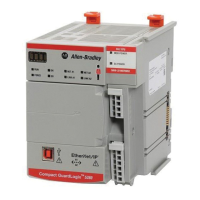Rockwell Automation Publication MOTION-RM003I-EN-P - February 2018 243
Bit Usage Status Condition Description
1 Optional/
C
Torque Notch Filter Tuning
Unsuccessful
When the Adaptive Tuning Configuration is set to
Enabled, this bit is set when an update to the
Torque Notch Filter Estimate, applied to the Torque
Notch Filter, does not eliminate all resonances
between the Torque Notch Filter Low Frequency
Limit and the Torque Notch Filter High Frequency
Limit
with magnitude above the Toque Notch Filter
Tuning Threshold. Otherwise, the bit is clear.
This bit is cleared by the Adaptive Tuning function
when the Axis state transitions to the Running state
or, when in the Running state, the Adaptive Tuning
Configuration transitions from Disabled to one of
the Torque Notch Filter Tuning enumerations.
2 Optional/
C
Torque Notch Filter Multiple
Frequencies
This bit is set when, the Adaptive Tuning function,
identifies multiple resonant frequencies that are
between the Torque Notch Filter Low Frequency
Limit and the Torque Notch Filter High Frequency
Limit whose magnitudes are above the Toque
Notch Filter Tuning Threshold. Otherwise, the bit is
clear.
This bit is cleared by the Adaptive Tuning function
when the Axis state transitions to the Running
state.
3 Optional/
C
Torque Notch Filter Frequency
Below Limit
This bit is set when the Adaptive Tuning function
identifies a frequency that is below the Torque
Notch Filter Low Frequency Limit but whose
magnitude is higher than the configured Toque
Notch Filter Tuning Threshold. Otherwise, the bit is
clear.
This bit is cleared by the Adaptive Tuning function
when the Axis state transitions to the Running
state.
4 Optional/
C
Torque Notch Filter Frequency
Above Limit
This bit is set when the Adaptive Tuning function
identifies a frequency that is above the Torque
Notch Filter High Frequency Limit but whose
magnitude is higher than the configured Toque
Notch Filter Tuning Threshold. Otherwise, the bit is
clear.
This bit is cleared by the Adaptive Tuning function
when the Axis state transitions from disabled to
enabled operation.
5 Optional/
C
Adaptive Tune Gain
Stabilization Active
This bit is set when the Adaptive Tune Gain Scaling
Factor is not equal to one. This indicates that the
Adaptive Tuning function is actively adjusting servo
loop gain values and the Torque Low Pass Filter
Bandwidth value to improve system stability.
This bit is cleared by the Adaptive Tuning function
when the Axis state transitions to the Running
state.
6-31 - Reserved -
The naming convention for individual bits within the CIP Axis Status RA
attributes is to append a 'Status' suffix to the CIP Axis Status RA condition. This
